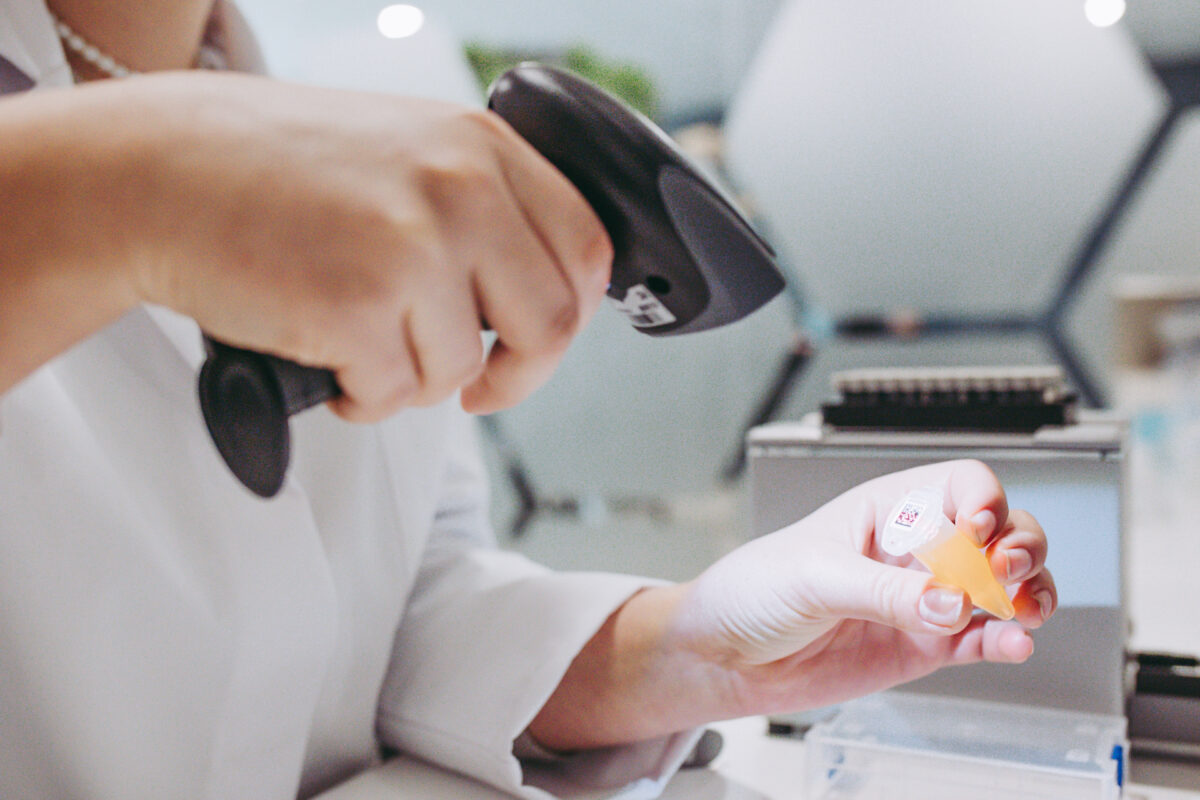

 By Chris Austin
3 min read
28 Feb 2024
By Chris Austin
3 min read
28 Feb 2024
Barcoding biological samples and integrating this information with laboratory sample management software offers a more efficient means for tracking a wide range of biospecimens. The blog below discusses sample barcoding and its advantages over traditional sample tracking methods.
Biological sample barcoding assigns a unique identifier to an individual biospecimen, analogous to barcodes used on consumer products. Barcodes provide a reliable means of cataloguing and tracking the location and application of samples used in a laboratory, particularly when integrated with sample management software.
Before barcoding was applied in laboratories, researchers employed various traditional methods to track biological samples, often relying on manual and time-consuming processes. One method still used by many labs is documentation in a lab notebook, where detailed records, handwritten notes, and labels are meticulously maintained. This method, however, is prone to human error and could lead to misinterpretation or loss of crucial information. Even when spreadsheets are used to manage and track sample inventories, there is still room for human error and mistakes.
Physical tagging systems, such as numbered or colour-coded labels, are often implemented to distinguish samples. While these methods are better than relying solely on written records, they still have limitations, especially when dealing with large-scale studies or when long-term storage is required. The absence of a standardized and universally applicable system makes data sharing and collaboration challenging.
Sample barcoding helps provide solutions for these challenges. While not all scientists transitioned from paper records or disjointed software solutions, there are some key reasons for the growing interest in sample barcoding and its integration with comprehensive lab information software.
Barcoding provides a unique identifier for each biological sample, reducing the chances of errors in sample identification. Integration with laboratory sample management software enables real-time tracking of sample locations, movements, and usage history. This metadata provides a more comprehensive view of a sample collection compared to manual sample management methods.
Combining barcodes with sample management software allows for efficient and accurate data entry. Researchers can quickly scan barcodes instead of manually entering sample information, reducing the risk of transcription errors. It streamlines data management by providing a centralized platform for storing and retrieving sample-related information.
Barcoding facilitates automation in sample-handling processes. Automated systems can scan and process samples more quickly and accurately than manual methods. This is particularly important in high-throughput laboratories where large numbers of samples need to be processed efficiently.
Barcoding helps maintain the integrity of samples by reducing the likelihood of mix-ups or contamination. By integrating with sample management software, researchers can ensure the reproducibility of experiments by accurately documenting and tracking sample conditions and parameters.
Barcoding and software integration helps laboratories adhere to regulatory and quality control standards. They also enhance traceability and auditability, which is crucial for compliance with various industry and research regulations.
Streamlining sample management processes through barcoding and software integration can save time and reduce operational costs. Automation and efficient data handling contribute to overall workflow optimization, allowing researchers to focus more on the scientific aspects of their work.
Integration with sample management software enables seamless integration with other laboratory systems, facilitating comprehensive data analysis. Researchers can correlate sample information with experimental results, helping them draw meaningful conclusions from their data.
Barcoding and sample management software facilitate collaboration by providing a standardized and easily shareable format for sample information. Researchers from different labs or institutions can more effectively share data, fostering collaborative efforts and accelerating scientific progress.
Combining barcoding and laboratory sample management software improves the efficiency, accuracy, and overall management of biological samples in research lab settings.
If you’re considering the eLabNext platform or are a current eLabNext customer who hasn’t taken advantage of sample barcoding yet, explore the Biobanking section of the eLabMarketplace or check the ZPL Printer add-on or FLUICS PRINT add-on. eLabNext can also provide a list of printers and scanners supporting sample barcoding. If you are a ZPL, Brady, or FLUICS customer looking to make your next steps on your digital journey and want to be the with the ‘Easiest to Use’ and ‘Best Value’ ELN provider, then request a demo or jump straight to your free 30-day trial of eLabNext.

 By eLabNext
By eLabNext
Gain valuable strategies for choosing the right lab space, fostering collaboration, and achieving more with less money.
Read more
 By Zareh Zurabyan
By Zareh Zurabyan
From data quality to ethical considerations, learn how to navigate AI challenges while optimising integration for enhanced lab operations.
Read more
 By eLabNext
By eLabNext
Learn how to optimise lab procurement as part of a robust inventory management regime. Explore best practices and streamline lab ops.
Read more
Schedule a Personal Demo for friendly expert guidance and a free lab workflow assessment.